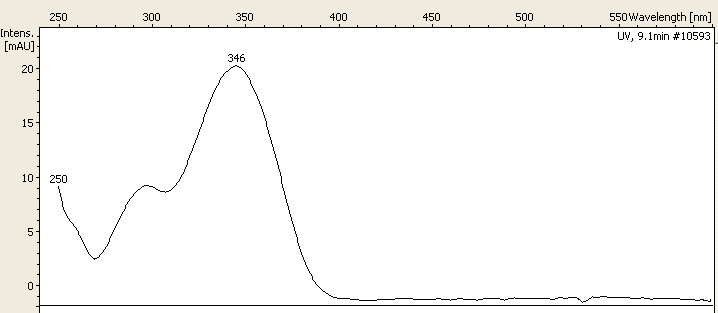Esculin on:
[Wikipedia]
[Google]
[Amazon]
Aesculin, also called æsculin or esculin, is a
National Standard Methods
MSOP 48 (Bile aesculin agar) and BSOPTP 2 (Aesculin hydrolysis test (UK)) 

coumarin
Coumarin () or 2''H''-chromen-2-one is an aromatic organic chemical compound with formula . Its molecule can be described as a benzene molecule with two adjacent hydrogen atoms replaced by an unsaturated lactone ring , forming a second six-me ...
glucoside
A glucoside is a glycoside that is chemically derived from glucose. Glucosides are common in plants, but rare in animals. Glucose is produced when a glucoside is hydrolysed by purely chemical means, or decomposed by fermentation or enzymes.
Th ...
that naturally occurs in the trees horse chestnut
The genus ''Aesculus'' ( or ), with notable species including buckeye and horse chestnut, comprises 13–19 species of flowering plants in the family Sapindaceae. They are trees and shrubs native to the temperate Northern Hemisphere, with ...
(''Aesculus hippocastanum''), California buckeye
''Aesculus californica'', commonly known as the California buckeye or California horse-chestnut, is a species of buckeye native to California and southwestern Oregon.
Description
Aesculus californica is a large deciduous shrub or small tree, u ...
(''Aesculus californica''), and prickly box (''Bursaria spinosa''). It is also found in daphnin
Daphnin is a plant toxin with the chemical formula C15H16O9 and is one of the active compounds present in the Eurasian and North African genus ''Daphne'' of the Thymelaeaceae, a plant family with a predominantly Southern Hemisphere distribution wi ...
(the dark green resin of ''Daphne mezereum
''Daphne mezereum'', commonly known as mezereum, mezereon, February daphne, spurge laurel or spurge olive, is a species of '' Daphne'' in the flowering plant family Thymelaeaceae, native to most of Europe and Western Asia, north to northern Scan ...
''), dandelion coffee
Dandelion coffee (also dandelion tea) is a herbal tea, tisane made from the root of the Taraxacum, dandelion plant. The roasted dandelion root pieces and the beverage have some resemblance to coffee in appearance and taste, and it is thus commonly ...
, and olive
The olive, botanical name ''Olea europaea'' ("European olive"), is a species of Subtropics, subtropical evergreen tree in the Family (biology), family Oleaceae. Originating in Anatolia, Asia Minor, it is abundant throughout the Mediterranean ...
bark. It is reported to be present in olive bark, but not in olive leaf; therefore, identification of aesculin in abundance in an olive extract indicates that the extract has been derived from olive bark.
Uses
Aesculin is also used in a microbiology laboratory to aid in the identification of bacterial species (especially ''Enterococci'' andListeria
''Listeria'' is a genus of bacteria that acts as an intracellular parasite in mammals. As of 2024, 28 species have been identified. The genus is named in honour of the British pioneer of sterile surgery Joseph Lister. ''Listeria'' species ...
). In fact, all strains of Group D Streptococci hydrolyze aesculin in 40% bile.
Aesculin hydrolysis test
Aesculin is incorporated into agar with ferric citrate and bile salts ( bile aesculin agar).MSOP 48 (Bile aesculin agar) and BSOPTP 2 (Aesculin hydrolysis test (UK))
Hydrolysis
Hydrolysis (; ) is any chemical reaction in which a molecule of water breaks one or more chemical bonds. The term is used broadly for substitution reaction, substitution, elimination reaction, elimination, and solvation reactions in which water ...
of aesculin forms aesculetin
Aesculetin (also known as esculetin, 6,7-dihydroxycoumarin and cichorigenin) is a derivative of coumarin. It is a natural lactone that derives from the intramolecular cyclization of a cinnamic acid derivative.
It is present in chicory and in many ...
(6,7-dihydroxycoumarin) and glucose
Glucose is a sugar with the Chemical formula#Molecular formula, molecular formula , which is often abbreviated as Glc. It is overall the most abundant monosaccharide, a subcategory of carbohydrates. It is mainly made by plants and most algae d ...
. Aesculetin forms dark brown or black complexes with ferric citrate, allowing the test to be read.
The bile aesculin agar is streaked and incubated at for 24 hours. The presence of a dark brown or black halo indicates that the test is positive. A positive test can occur with ''Enterococcus
''Enterococcus'' is a large genus of lactic acid bacteria of the phylum Bacillota. Enterococci are Gram-positive cocci that often occur in pairs ( diplococci) or short chains, and are difficult to distinguish from streptococci on physical ch ...
'', ''Aerococcus
''Aerococcus'' is a genus of bacterium in the phylum Bacillota (Bacteria). The genus was first identified in 1953 from samples of air and dust as a catalase-negative, gram-positive coccus that grew in small clusters. They were subsequently found ...
'', and ''Leuconostoc
''Leuconostoc'' is a genus of gram-positive bacteria, placed within the family of Lactobacillaceae. They are generally ovoid cocci often forming chains. ''Leuconostoc'' spp. are intrinsically resistant to vancomycin and are catalase-negative (w ...
''. Aesculin will fluoresce
Fluorescence is one of two kinds of photoluminescence, the emission of light by a substance that has absorbed light or other electromagnetic radiation. When exposed to ultraviolet radiation, many substances will glow (fluoresce) with color ...
under long wave ultraviolet
Ultraviolet radiation, also known as simply UV, is electromagnetic radiation of wavelengths of 10–400 nanometers, shorter than that of visible light, but longer than X-rays. UV radiation is present in sunlight and constitutes about 10% of ...
light (360 nm) and hydrolysis of aesculin results in loss of this fluorescence.
''Enterococcus'' will often flag positive within four hours of the agar being inoculated.


References
{{coumarin Coumarin glycosides Microbiological media ingredients